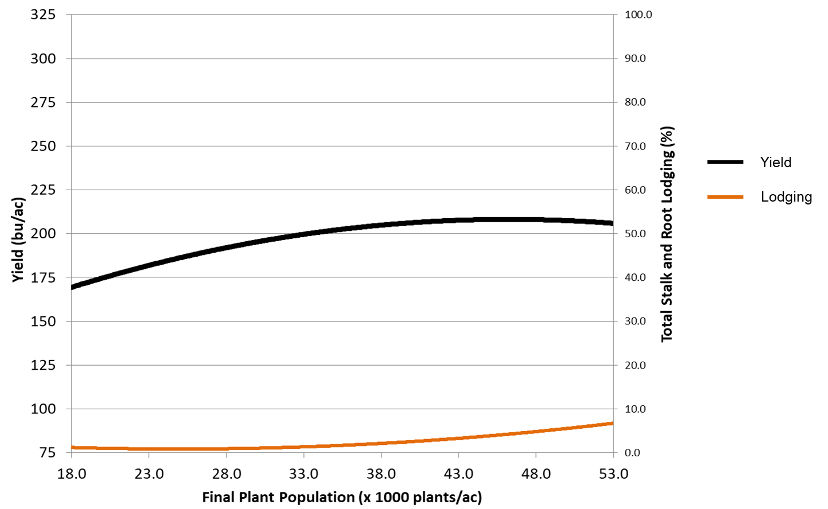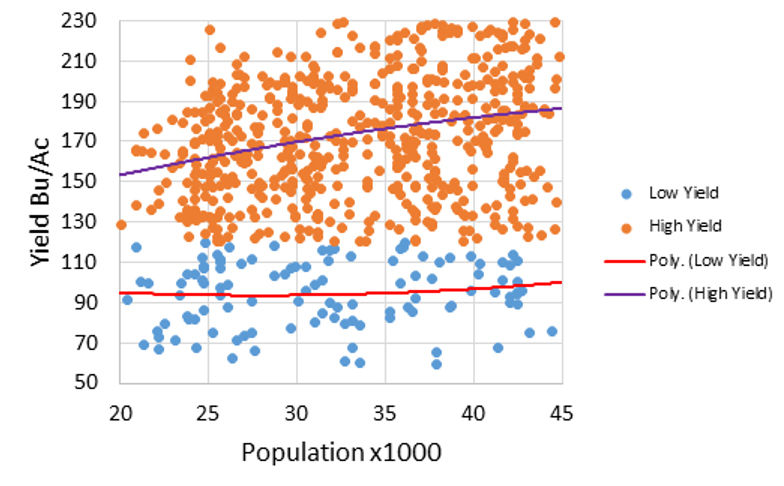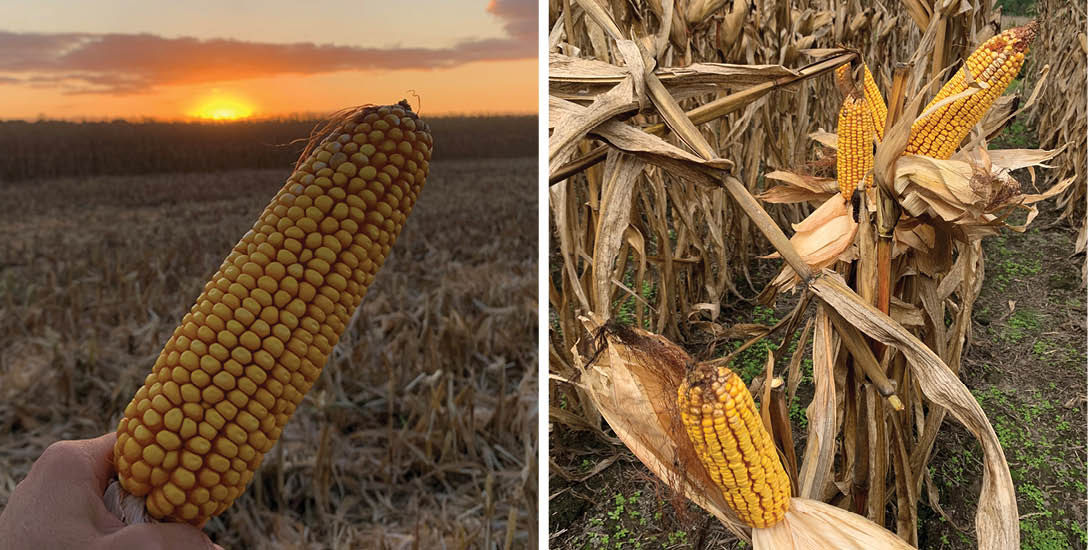9 READ-TIME
Factors Impacted by Increasing Plant Populations in Corn
May 24, 2021
Advances in corn product genetics combined with changes in agronomic practices have resulted in substantial increases in corn yields over the past century. North American corn yields today average 172 bu/acre, more than a five-fold increase from what they averaged in the 1930s at 30 bu/acre.1,2,3 Corn breeders, selecting for higher yielding corn products under increased planting densities, produced corn products well adapted for higher population densities by increased “crowding stress” tolerance.4 These yield gains have been attributed primarily to increased plant density rather than increased per-plant yield. Subsequently, optimal plant populations have increased strikingly in recent years. Along with product selection, corn producers can make decisions on maximizing plant populations for yield and profit by understanding how plant density affects yield potential.
Modifications to Yield Components
Yield components of corn, including ears per acre, kernel rows per ear, kernels per row, and kernel size, directly impact yield. All are influenced by environment, genetics, and agronomic practices. Agronomic practices that incorporate higher plant densities have been shown to increase yield potential (Table 1). These yield advances are attributed to the ability of corn plants to sustain a high harvest index at increased plant populations.1,5 Harvest index (HI) is the ratio of grain relative to overall plant biomass. A high HI is the result of partitioning more plant resources into grain rather than overall plant biomass, resulting in enhanced grain yield.6 Plant breeders select for corn products that can partition dry matter to the ear and enhance photosynthesis during grain fill.
Table 1. Corn product average yield (bu/acre) at increasing planting populations in different decades.*

Environmental stresses can cause detrimental effects to plants, such as higher numbers of barren plants or standability issues leading to lodging and harvest problems.7 However, compared to older corn products, today’s corn products have been bred to tolerate higher population densities, producing consistently greater yields with less lodging at increased plant populations.8
A multi-year Canadian study evaluating the effect of population density on yield showed that optimal harvest populations for maximizing yield were around 39,000 plants per acre (Table 2). In addition, staygreen, lodging and ear intactness all deteriorated with increasing population density, while test weight and harvest moisture remained relatively constant.
Table 2. Grain corn population study, 2011-2019.*

Results from the same study demonstrated the relationship between final plant population density, yield and lodging. As populations increased beyond approximately 42,000 plants per acre, the increase in lodging correlated with a decrease in yield (Figure 1).
Figure 1. Average yield and lodging by final Population, 2011- 2020.

Source: Bayer Canada, Crop Science, Market Development 2011-2019.
In dryland conditions in Western Canada where yields are typically lower, average yields did not show an increase beyond 30,000 plants per acre (Figure 2). Planting recommendations are much lower in these dryland areas than in irrigated areas where the recommended plant populations are close to 40,000 plants per acre for optimal yield. In dryland (low yielding) environments where competition for resources is greater, the yield line is basically flat. By comparison, in the irrigated (high yielding) environments the response curve is much steeper indicating increasing average yields with increasing population densities.
Figure 2. Average yield and by final population in irrigated and dryland environments.

Source: Bayer Canada, Crop Science, Market Development.
In an effort to provide specific product population recommendations, Bayer has been using an innovative planter technology, the Genotype by Environment Narrative planter (GEN), to help understand and characterize corn product performance in response to plant population and environment. This internally-developed tool provides the technical field teams the ability to simultaneously plant multiple corn products at different seeding rates across a field. These unique planting capabilities generate over 100,000 detailed yield observations each season across diverse growing conditions. This program provides data for our agronomy experts to optimize product performance and recommendations for all corn-growing regions in the United States.
The Benefits of Ear Plasticity
Ear plasticity is the ability of a corn product demonstrating flex, semi-flex, and limited-flex ear growth development to manage kernel development under a variety of conditions. Plant densities impact ear plasticity. Corn products with a greater degree of ear plasticity or flex can increase ear size in response to lower plant densities (Figure 3). Determinate or 'fixed' ear type corn products typically have greater yields at high plant densities. Contrasting yield components can be observed when flex and fixed ear types are evaluated. For instance, a flex ear corn product can have a greater number of kernels per area, while a fixed ear corn product can have heavier individual kernels under the similar conditions.9 Understanding the ear plasticity of specific products influences planting density decisions.10

Figure 3. Kernel development can be managed with corn products with a greater degree of ear plasticity. Photo courtesy of Josh Roberson, Field Sales Representative, Bayer Crop Science.
For more information on specific corn products and ear plasticity (flex), please refer to your DEKALB® Seed Guide and talk to your local technical agronomist for recommendations.
Enhanced Photosynthesis
Plant populations near 45,000 plants per acre may be required to consistently achieve 300 bu/acre yield goals of the future.9 Photosynthesis is one plant process that remains a target for genetic improvement to potentially increase crop yield.1,11,12 Currently, photosynthesis is being improved with leaf angle for maximizing sunlight capture and stay-green characteristics for prolonging the duration of photosynthesis during grain fill. Leaves angled 75 percent with the horizontal have enough sunlight to saturate photosynthesis, while the remaining direct light penetrates lower canopy leaves.11 There is evidence that such upward angled leaves were introduced to modern corn products through a mutation of an auxin binding protein.13 Auxin distribution and sensitivity is affected by red to infrared (R:FR) changes. Plants are able to detect neighboring plants by changes in R:FR light in the canopy. Close plant spacing can result in elongated growth, less branching, and redistribution of leaves to the upper canopy to avoid lower shaded leaves.
Delayed leaf senescence, or stay-green characteristics, allow plants to continue photosynthesis during grain fill. Maintaining photosynthesis during grain fill helps increase kernel weight by providing more energy for the plant to convert sunlight into stored energy. However, corn products with greater tolerance to disease can maintain leaf health and photosynthesize late into grain fill stages and potentially result in a moderate increase in kernel weight.6
Improved Drought Tolerance and Nitrogen Utilization
Plants selected through breeding to respond to higher planting densities have also been selected for improved drought resistance. Drought tolerant corn products contain multiple genes that influence their ability to withstand periods of drought. The ability to tolerate drought is a quantitative measurement whereby the level of expression is controlled by multiple genes of differing effects and is influenced by the environment. Breeding corn products to incorporate multiple genes for drought tolerance has enabled corn products to withstand environmental stresses such as drought without suffering yield losses.
Improved corn products that can be planted at higher seeding rates have also been selected for improved nitrogen (N) use efficiency. A study of N use and efficiency with corn products from four decades (1970s, 1980s, 1990s, and 2000s) demonstrated that modern corn products can utilize N more efficiently.6 When planted under low N (approximately 63 lb/acre) conditions, corn products released in the early 1970s and 2000s had 17 and 5.8 percent barrenness, respectively.6 The newer corn products were able to more efficiently distribute carbon and N to the shoot and ear even without fertilization, despite N being limited. It is thought that corn product selection has led to plants with traits for enhanced metabolic pathways to the ear. Smaller root systems typically develop on corn plants grown at high densities and can limit the ability of plants to reach nutrients. However, improved corn products can efficiently take up N and partition the nutrient to developing ears.
Summary
Corn plant architecture and metabolic processes have been altered over time, resulting in improvements to the harvest index and increasing yield potential in corn products. This increase in yield can be attributed to genetic improvement from directed plant breeding as well as improvements in agronomic practices. Genetic modifications to N uptake and use efficiency, enhanced photosynthesis, as well as improvements to Harvest Index and canopy architecture have been key to increasing plant population density and improving yields with corn products.
Sources
1 Duvick, D.N. 2005. The contribution of breeding to yield advances in maize (Zea Mays. L.). Advances in Agronomy vol 86:83-145.
2 Moussavi, M., Babaeian, M., Tavassoli, A., and Asgharzade, A. 2011. Effect of plant density on yield and yield components of corn hybrids (Zea Mays). Scientific Research and Essays vol 6:4821-4825
3 United States Department of Agriculture. National Agriculture Statistics Service. 2021. Corn: yield by year, US. https://www.nass.usda.gov/Charts_and_Maps/Field_Crops/cornyld.php
4 Sangoi, L. 2001. Understanding plant density effects on maize growth and development: an important issue to maximize grain yield. Cienc. Rural vol 31:159-168 https://doi.org/10.1590/S0103-84782001000100027
5 Tollenaar, M. 1989. Genetic improvement in grain yield of commercial maize hybrids grown in Ontario from 1959 to 1988. Crop Science vol 29:1365-1371. https://doi.org/10.2135/cropsci1989.0011183X002900060007x
6 Haegele, J.W., Cook, K.A., Nichols, D.M., and Below, F.E. 2013. Changes in nitrogen use traits associated with genetic improvement for grain yield of maize hybrids released in different decades. Crop Science vol 53:1256-1268. https://doi.org/10.2135/cropsci2012.07.0429
7 Tang, L., Ma, W., Ali Noor, M., Li, L., Hou, H., Zhang, X., and Zhao, M. 2018. Density resistance evaluation of maize varieties through new “density-yield model” and quantification of varietal response to gradual planting density pressure. Scientific Reports vol 8. 17281. https://doi.org/10.1038/s41598-018-35275-w
8 Watters, H. 2011. Evaluation of plant populations across 150 years of corn genetics. Ohio State University. http://agcrops.osu.edu
9 Haegele, J.W., Becker, R.J., Henninger, A.S., and Below, F.E. 2014. Row arrangement, phosphorus fertility, and hybrid contributions to managing increased plant density of maize. Agronomy Journal vol 106:1838-1846. https://doi.org/10.2134/agronj2013.0382
10 Fromme, D.D., Spivey, T.A., Grichar, W.J. 2019. Agronomic response of corn (Zea mays L.) hybrids to plant populations. International Journal of Agronomy vol 2019:1-8. https://www.hindawi.com/journals/ija/2019/3589768/
11 Long, S.P., Zhu, X-G., Naidu, S.L., and Ort, D.R. 2006. Can improvement in photosynthesis increase crop yields? Plant, Cell & Environment vol 29:315-330. https://doi.org/10.1111/j.1365-3040.2005.01493.x
12 Ren, B., Liu, W., Zhang, J., Dong, S., Liu, P, and Zhao, B. 2017. Effects of plant density on the photosynthetic and chloroplast characteristics of maize under high-yielding conditions. Naturwissenschaften vol 104:12 https://pubmed.ncbi.nlm.nih.gov/28246890/
13 Fellner, M., Ford, E.D., and Van Volkenburgh, E.V. 2006. Development of erect leaves in a modern maize hybrid is associated with reduced responsiveness to auxin and light of young seedlings in vitro. Plant Signal Behavior vol 1:201-11. https://doi.org/10.4161/psb.1.4.3106
Legal Statements
Performance may vary from location to location and from year to year, as local growing, soil and weather conditions may vary. Growers should evaluate data from multiple locations and years whenever possible and should consider the impacts of these conditions on the grower’s fields.
Bayer and DEKALB® are registered trademarks of Bayer Group. Used under license. ©2021 Bayer Group. All rights reserved. 3013_S4_CA
